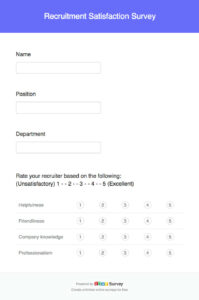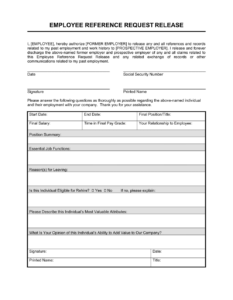Utilizing such a form offers numerous advantages. It saves time and effort by providing a clear framework for the request, reducing ambiguity and back-and-forth communication. It also helps ensure legal compliance by focusing on job-related inquiries and avoiding discriminatory questions. Furthermore, a well-designed form can enhance the professionalism of the hiring organization and improve the candidate experience.
This foundation of understanding will be further explored through discussions on best practices for creating and using these valuable tools, common legal considerations, and effective strategies for obtaining insightful and valuable feedback from references.
Key Components of an Effective Reference Request
Several essential elements contribute to a comprehensive and effective reference request. These components ensure clarity, promote efficiency, and maximize the value of the information received.
1. Candidate Information: This section should clearly identify the candidate by full name and ideally include the position they are applying for. Including the candidate’s contact information can be helpful for verification purposes.
2. Requester Information: Contact details for the individual or organization making the request are crucial. This allows the reference provider to easily clarify any questions or provide additional information.
3. Purpose of Request: A concise explanation of why the reference is being sought provides context and emphasizes the importance of the information being requested.
4. Employment Dates: Specific dates of the candidate’s employment with the reference provider help verify the accuracy of the information and contextualize the feedback.
5. Job Title and Responsibilities: Knowing the candidate’s previous role and responsibilities helps the reference provider tailor their feedback to the requirements of the new position.
6. Specific Questions: Open-ended questions focusing on relevant skills, experience, and work ethic encourage detailed and insightful responses. Providing space for narrative answers is beneficial.
7. Confidentiality Statement: Including a statement regarding the confidentiality of the provided information can encourage candid feedback and demonstrate professional conduct.
8. Authorization and Signature Lines: Providing space for the reference provider to sign and date the form confirms their consent and adds legitimacy to the document.
A thoughtfully constructed request, incorporating these components, contributes significantly to informed hiring decisions and ensures a smooth and professional process for all parties involved.
How to Create an Employment Reference Request
Creating a well-structured request form is essential for gathering relevant and insightful information about potential employees. A systematic approach ensures consistency, efficiency, and professionalism throughout the hiring process.
1: Define the Purpose: Clearly outline the objective of the reference check. Specifying the role for which the candidate is being considered provides valuable context for the reference provider.
2: Gather Candidate Information: Include the candidate’s full name, contact information, and the specific position they are applying for. This allows for accurate identification and facilitates communication if needed.
3: Structure the Request: Organize the form logically with distinct sections for candidate information, requester information, employment dates, and specific questions.
4: Craft Effective Questions: Focus on open-ended questions that encourage detailed responses related to the candidate’s skills, experience, and work ethic. Avoid leading or biased questions.
5: Incorporate Legal Considerations: Ensure compliance with relevant laws and regulations by avoiding discriminatory or irrelevant inquiries. Focus on job-related questions only.
6: Include Authorization and Consent: Provide space for the reference provider to sign and date the form, indicating their consent for the information to be shared.
7: Maintain a Professional Tone: Use clear and concise language throughout the form, ensuring a professional and respectful tone.
8: Review and Refine: Before using the form, review and refine the content to ensure clarity, accuracy, and completeness. Consider seeking legal counsel to ensure compliance with applicable laws and regulations.
A well-crafted form, developed through careful planning and attention to detail, facilitates efficient and insightful information gathering, contributing significantly to informed hiring decisions. This structured approach streamlines the process for all parties involved, fostering a professional and respectful exchange of information.
Standardized forms for soliciting employment references provide a crucial structure for gathering consistent and relevant information about prospective employees. A well-designed form streamlines the process, saving time and effort for both the requester and the reference provider. Furthermore, it promotes legal compliance by focusing inquiries on job-related criteria. Key components such as clear candidate identification, specific questions regarding skills and experience, and authorization for information release contribute to a comprehensive and effective request. Careful consideration of these elements ensures a professional and respectful exchange of information, leading to more informed hiring decisions.
Effective use of these tools represents a commitment to due diligence and best practices within the hiring process. This structured approach fosters fairness, transparency, and ultimately contributes to building strong and successful teams. Organizations are encouraged to review and refine their processes regularly, ensuring alignment with evolving legal landscapes and best practices in talent acquisition. This ongoing commitment to improvement underscores a dedication to making well-informed hiring decisions, leading to greater organizational success.


